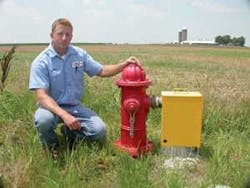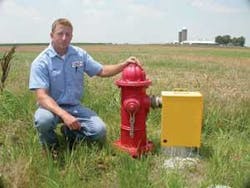Automatic Hydrant Flushers Save Man Hours
Consolidated Water Services (CWS), located in Centralia, IL, operates seven water systems serving approximately 6000 customers. A family business started in 1976 by Jim Green, the company, now operated by his son Jason, was struggling with maintaining chlorine residuals and other water quality issues, mainly on dead-end water mains.
Facing increasing regulations, tight budgets, and many long water mains covering miles of geography, CWS was looking for new ways to increase its operating efficiency.
One task that took many hours for the seven employees of CWS was water main flushing. The older parts of their systems had several locations were chlorine residuals and manganese issues were a constant headache.
“Flushing, especially early in the year, was taking my employees away from other, more productive tasks” said Jason Green.
Additionally, in the newer areas, the growth required the installation of long water mains, serving very few customers. These long mains would lose chlorine residuals due to low demand.
In some cases, CWS employees would spend two straight days each spring flushing each one of these troublesome dead-ends to boost the residuals from near zero to 2 ppm. This process prevented the completion of other tasks and caused great strain on the pumps and tanks within the systems. When finished, however, residual levels would usually stay high until the following spring.
“Our old way of flushing during daytime hours would sometimes run our tanks so low that the alarms would sound. We really preferred to flush at night but we didn’t have the manpower,” Green said.
This flushing process was expensive due to travel time and actual time spent flushing, not to mention wear and tear on vehicles and pumps. Because flushing was being conducted during daytime hours, customers complained of water waste and in some cases loss of water pressure. Flushing also caused customers to experience some discolored water.
Automatic Flushing
Early in 2003, CWS placed five Kupferle model #9700 automatic hydrant flushers at strategic points on the outskirts of the distribution systems. The automatic flushers install onto any male 2-1/2" NST connection, and are capable of flushing at any time of day for any length of time.
The valve and controller are located inside the aluminum, epoxy coated, and lockable box. The water flows into the box and out the perforated bottom. Or, if attaching a hose or pipe on the discharge is desired, one portion of the perforated bottom can be removed, gaining access to a female 2" IP connection. Water flow can also be controlled to obtain the proper velocity needed for the size of the pipe and to control upstream pressure loss.
Options are available to provide a sampling bibb inside the box, adding dechlorination tablets within the box, and metering the water flushed as well. Standard box colors include red and yellow, with other colors available upon request.
Because the flushers are portable, CWS’s plan was to place the devices on five dead-ends at a time, moving them around until springtime flushing was accomplished, and then leaving them on the trouble spots until winter.
For the long mains, the devices were set to flush each morning at 2 a.m. for one to two hours. Tests were made periodically until residuals reached 2 ppm, and then the device was moved.
“We found our flushers needed to be at the long dead-ends for about eight days, flushing for two hours each night, to gain the residuals we need,” Green said.
Flushing in the early morning hours, when demand was low, greatly eased the strain on the pumps, was inconspicuous, and allowed sediment to settle before customers woke for the day.
For more information on the model #9700 automatic flushing system, visit the Kupferle Foundry website at www.hydrants.com.

